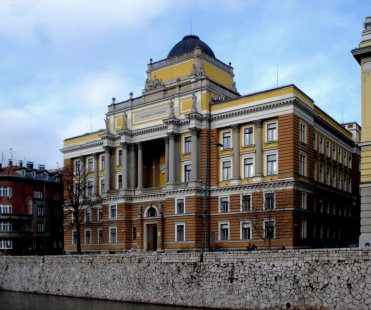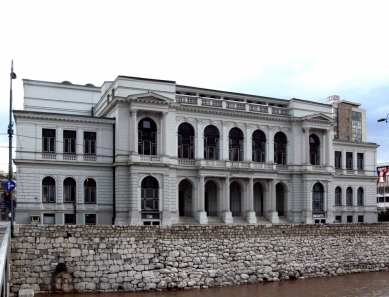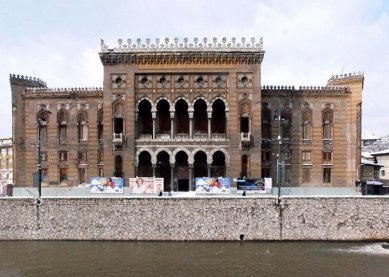
The name of architect Pařík was not known even in Sarajevo a few years ago
Sarajevo/Prague - Visitors to the Bosnian metropolis Sarajevo encounter the architect of Czech origin Karel Pařík almost everywhere they go. Just stroll along the Miljacka River, which flows through the entire city - the National Museum, the National Theatre, and the headquarters of the University of Sarajevo all bear the mark of the native from Veliš near Jičín. Pařík, whose death marks 70 years on June 16, designed a number of religious buildings for various religious confessions in Sarajevo, and his houses can also be found elsewhere in Bosnia.
The name of the architect, who came to the Balkans like many other Czechs after the Austro-Hungarian annexation of the former Turkish province in 1878, was until recently almost unknown even to the art-loving Sarajevans. The Bosnian architect Branka Dimitrijevičová helped to revive the memory of "Karlo Paržika" by writing a dissertation about this co-creator of modern Sarajevo, and later she promoted Pařík's architectural work and organized a large exhibition in his honor five years ago.
"Today, all future architects studying in Sarajevo learn about him, so at least they should know most of Pařík's buildings in Sarajevo," says Dimitrijevičová. However, it is somewhat worse with the city’s regular inhabitants despite all efforts. Almost everyone in the city knows the current headquarters of the Faculty of Islamic Studies or the Protestant church adorning the waterfront, where the Academy of Fine Arts is located today, but even employees of these institutions often have no idea about their architect.
Karel Pařík dedicated his entire life to Bosnia. A graduate of a construction school and the Academy of Fine Arts in Vienna, he arrived in Sarajevo in the spring of 1884 at just under twenty-seven years old and almost never left the Balkan country. He earned a good reputation right at the start when he and his classmate, Croatian Josip Vancaš, designed the Catholic Cathedral, which still dominates the square in close proximity to the ancient Sarajevo center - Baščaršija.
The building, combining Gothic and Romanesque architecture, seemed to foreshadow Pařík's career, which was characterized, until the turn of the 20th to 30th century, mainly by historical styles. His first independent project, the headquarters of the pension fund near the cathedral, also received a neo-Renaissance facade, similar to the boy's gymnasium. In designing the school for Sharia judges, where the Islamic faculty is located today, Karel Pařík drew inspiration from the Moorish style.
In the late 1880s, Pařík was also involved in the inception of the Sarajevo City Hall, built on the eastern promontory of the historical center, which after World War II became the National Library. The building, inspired by the famous Cairo mosque of Kemal II, which burned down during the civil war in August 1992, was completed by other architects. However, the triangular floor plan remained from Pařík's design, which was rejected by the highest representative of the Austrian government for Bosnia, Benjamin Kállay.
Besides his own architectural work, Karel Pařík served in government positions and rose to chief building counselor. He thus shaped the appearance of Sarajevo and other cities in Bosnia and Herzegovina by overseeing the urban development of the country. Moreover, significant works by Pařík can also be found outside Sarajevo - alongside the residence of the Orthodox Herzegovinian metropolitan in Mostar, there are buildings for courts (Zenica, Foča, Gacko). He also designed spa facilities in the Croatian resort of Kupari and renovated the cathedral in the Albanian city of Shkodër.
After retiring in 1916, Pařík, who was brought closer to Czechs a year ago by David Vávra in several episodes of the television show *Šumné stopy*, taught at the Sarajevo Technical School. As an architect, Pařík most often worked for the Catholic Church between the wars. In total, he built over one hundred buildings in Bosnia and the surrounding countries, a third of which were funded by the local archbishopric. One of his last projects was the Sarajevo Church of St. Joseph, built in 1939. The square in front of this church has carried Pařík's name since the fall of 2008.
The name of the architect, who came to the Balkans like many other Czechs after the Austro-Hungarian annexation of the former Turkish province in 1878, was until recently almost unknown even to the art-loving Sarajevans. The Bosnian architect Branka Dimitrijevičová helped to revive the memory of "Karlo Paržika" by writing a dissertation about this co-creator of modern Sarajevo, and later she promoted Pařík's architectural work and organized a large exhibition in his honor five years ago.
"Today, all future architects studying in Sarajevo learn about him, so at least they should know most of Pařík's buildings in Sarajevo," says Dimitrijevičová. However, it is somewhat worse with the city’s regular inhabitants despite all efforts. Almost everyone in the city knows the current headquarters of the Faculty of Islamic Studies or the Protestant church adorning the waterfront, where the Academy of Fine Arts is located today, but even employees of these institutions often have no idea about their architect.
Karel Pařík dedicated his entire life to Bosnia. A graduate of a construction school and the Academy of Fine Arts in Vienna, he arrived in Sarajevo in the spring of 1884 at just under twenty-seven years old and almost never left the Balkan country. He earned a good reputation right at the start when he and his classmate, Croatian Josip Vancaš, designed the Catholic Cathedral, which still dominates the square in close proximity to the ancient Sarajevo center - Baščaršija.
The building, combining Gothic and Romanesque architecture, seemed to foreshadow Pařík's career, which was characterized, until the turn of the 20th to 30th century, mainly by historical styles. His first independent project, the headquarters of the pension fund near the cathedral, also received a neo-Renaissance facade, similar to the boy's gymnasium. In designing the school for Sharia judges, where the Islamic faculty is located today, Karel Pařík drew inspiration from the Moorish style.
In the late 1880s, Pařík was also involved in the inception of the Sarajevo City Hall, built on the eastern promontory of the historical center, which after World War II became the National Library. The building, inspired by the famous Cairo mosque of Kemal II, which burned down during the civil war in August 1992, was completed by other architects. However, the triangular floor plan remained from Pařík's design, which was rejected by the highest representative of the Austrian government for Bosnia, Benjamin Kállay.
Besides his own architectural work, Karel Pařík served in government positions and rose to chief building counselor. He thus shaped the appearance of Sarajevo and other cities in Bosnia and Herzegovina by overseeing the urban development of the country. Moreover, significant works by Pařík can also be found outside Sarajevo - alongside the residence of the Orthodox Herzegovinian metropolitan in Mostar, there are buildings for courts (Zenica, Foča, Gacko). He also designed spa facilities in the Croatian resort of Kupari and renovated the cathedral in the Albanian city of Shkodër.
After retiring in 1916, Pařík, who was brought closer to Czechs a year ago by David Vávra in several episodes of the television show *Šumné stopy*, taught at the Sarajevo Technical School. As an architect, Pařík most often worked for the Catholic Church between the wars. In total, he built over one hundred buildings in Bosnia and the surrounding countries, a third of which were funded by the local archbishopric. One of his last projects was the Sarajevo Church of St. Joseph, built in 1939. The square in front of this church has carried Pařík's name since the fall of 2008.
The English translation is powered by AI tool. Switch to Czech to view the original text source.




0 comments
add comment










